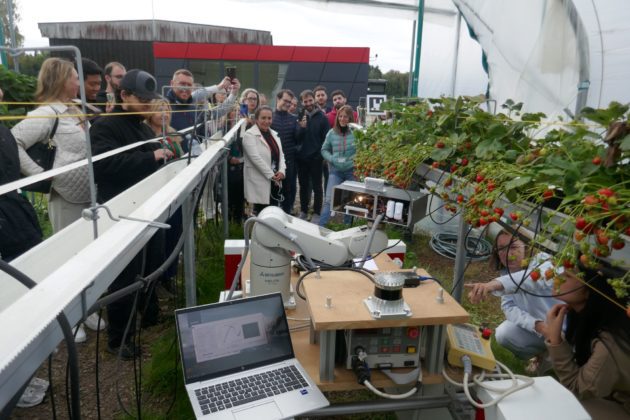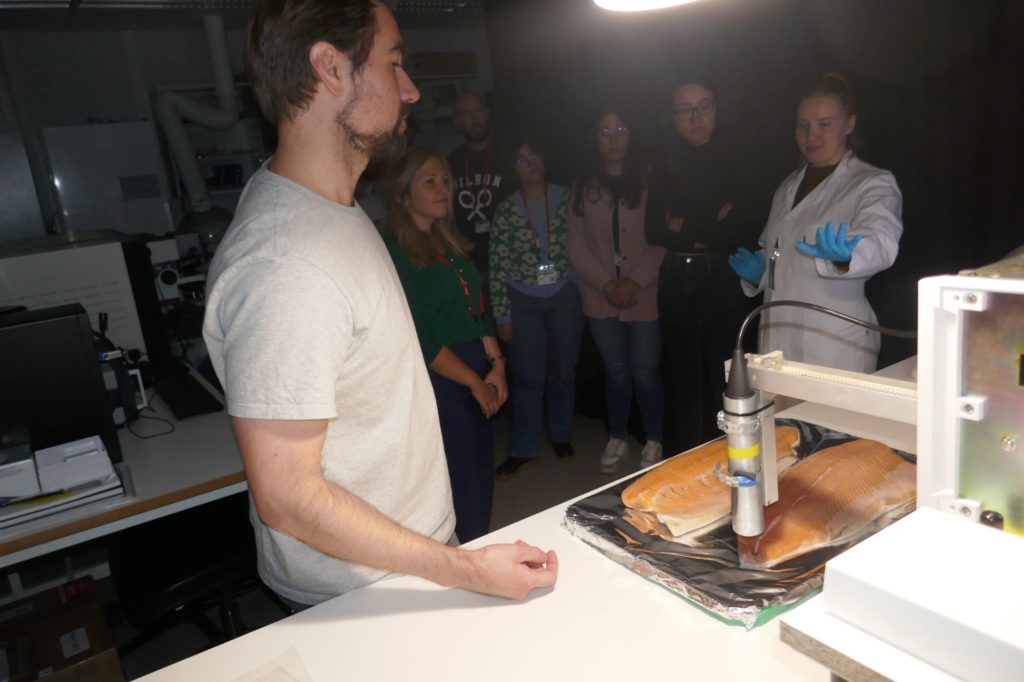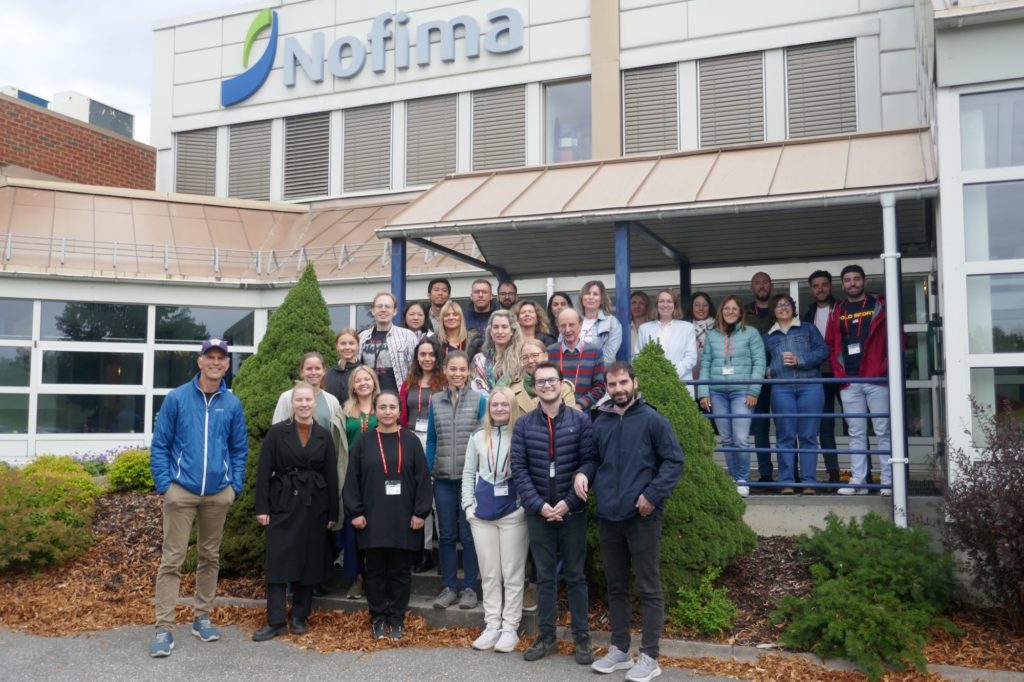“This is the future of food research, a robot that can also measure components”

These words belong to Maria Tarapoulouzi. She is a post.doc at the University of Cyprus, and she participates in spectroscopy courses for young researchers at Nofima.
She has just returned from the strawberry research greenhouse at NMBU. Here, researchers are testing, among other things, how the agricultural robot Thorvald can be used to measure the components in strawberries, and in the long term be able to pick the strawberries just as they have the correct ripening degree.
There is considerable international interest in research on rapid methods for measuring food quality, and Nofima researchers have cutting-edge expertise in the field. In mid-September, around 30 young scientists from different European countries participated in a three-day spectroscopy course at Nofima. The visit to the strawberry greenhouse, where participants got to see and test how the measurement takes place, was just one of several practical tasks on the course.
Effective way to measure the quality of food and raw materials without spoiling them
Spectroscopic measurement methods are methods that use light spectra to measure various properties in, for example, food and raw materials. These methods are fast and non-destructive and can be used in instruments that stand on the production lines in the food industry.
The Nofima course gave participants insight into the two spectroscopy technologies, NIR and Raman. NIR is a relatively widespread measurement method in food research in Europe. Raman, on the other hand, few people use, and the technology was unknown to most young researchers. They got to see what benefits use NIR or Raman can bring to food industries.
“For us, this is an excellent opportunity to share the knowledge we are developing both at Nofima and in DigiFoods. Several of the young researchers indicated that they would like a research stays at Nofima, which creates completely new opportunities to develop both knowledge and networks,” says Jens Petter would. He is a senior scientist at Nofima and heads SFI DigiFoods – Centre for Research-based Innovation. He is also Norway’s representative in the EU COST network SensorFINT, of which the spectroscopy course is a part.
The young researchers work with different raw materials and foods and use different methods.

Measures ingredients in milk and other dairy products
Renata Kostovska is in the third year of her PhD with VistaMilk, Teagasc and UCC (University College Cork) in Ireland. She uses Raman spectroscopy in the lab to analyze milk and other dairy products, such as butter and whipping cream. The milk she analyses comes from cows that have eaten novel types of grass-based feed, is from different cow breeds and from different seasons. Among other things, she is studying the fatty acid composition of the milk and the results she comes up with will be combined with the Raman data and used to predict the milk composition for the following years, by using this rapid, non-invasive method.
“This course has been really inspiring. Like taking part in how spectroscopy can be used in industry, in the barn or in the field, and a more comprehensive picture of how different spectroscopic technologies can complement each other. It has given me increased knowledge and ideas for collaboration between VistaMilk and Nofima, and how I can expand my own work,” says Renata Kostovska.
Halloumi – an important part of Cypriot culture
Halloumi is popular – and the most important Cypriot export. Real Halloumi is made on sheep’s and goat’s milk (with low percentages or no use of cow’s milk), following traditional recipes, and the cheese has EU status as protected local food as it has recently gained a PDO label. Nevertheless, there are many imitations on the market and they often also use the Halloumi name.
In her laboratory at the University of Cyprus, Maria Tarapoulouzi works to identify the origin of the milk in various cheese samples. The goal is to expose illegitimate halloumi, thus securing the livelihood of the dairies that produce real, traditional halloumi.
“Purchasing a spectroscopic instrument that can be used for these analyses is high on both my and the university’s wish list. In this course, I have both learned how NIR and Raman can be used in practice, and understood which functions are important to satisfy the needs we have. For example, it must be able to handle liquids, such as milk,” says Maria Tarapoulouzi. And adds that she hopes for both closer collaboration and a research stay at Nofima.
“Forever chemicals” in water
Nataliia Sivchenko is a project manager at DOSCON AS, which among many other projects analyses the quality of raw water, drinking water and wastewater. She holds a PhD in water and environmental engineering from NMBU and is a part of the team that develops methods for analysing Contaminants of Emerging Concern (CECs) in water. Among these is an on-line instrument that can identify PFAS components and their concentrations in water. PFAS, often called “forever chemicals”, are a group of long-lasting substances that break down very slowly over time. There are thousands of these chemicals, and they are used in various products we encounter daily. Studying and understanding their potential risks to our health and the environment is difficult due to their widespread presence.
PFAS are everywhere, found in water, air, fish, and soil worldwide. Because they persist in the environment, they are also detected in people and animals’ blood across the globe, as well as in various food products and water. Scientific research suggests that exposure to certain PFAS in our environment can be associated with harmful health effects in both humans and animals.
“During this course, I have gained a much greater understanding of how we can apply chemometrics in our research. For us, this will be a new, useful and very interesting way of working,” says Nataliia Sivchenko.
Watermelon measurements in the field
In order for Spanish farmers to be sure that they harvest the watermelons at the right time, some melons are analyzed in a laboratory. PhD student Miguel Vega-Castellote at the University of Corboda is in the process of developing an NIR application that can be used in a handheld sensor. This sensor will then allow farmers to take them out into the fields and make the measurements directly there, without damaging the melons.
“The application I’m working on measures the sugar content of watermelon to predict when they should be harvested. It has been very useful for me to learn more about how the Nofima scientists use both NIR and Raman to measure sugar content in strawberries. Some of this research I have taken part in before. Since I was on a three-month research stay at Nofima last year,” says Miguel Vega-Castellote.
One wish after completing the doctoral degree is to continue research on spectroscopy as a postdoc at Nofima and DigiFoods.

Networks in food and spectroscopy
EU COST action SensorFINT is led by Dolores Perez Marin, professor at the University of Cordoba, Spain. In addition to arranging the annual SensorFINT conference, the network focuses on education and development of young researchers and spends a significant proportion of the funds on exchange and competence enhancement through courses such as this at Nofima.
Link to website: SensorFINT | CA19145 – European Network for assuring food integrity using non-destructive spectral sensors
Contact person
Research areas
Quality and measurement methods
Topics
Spectroscopy
